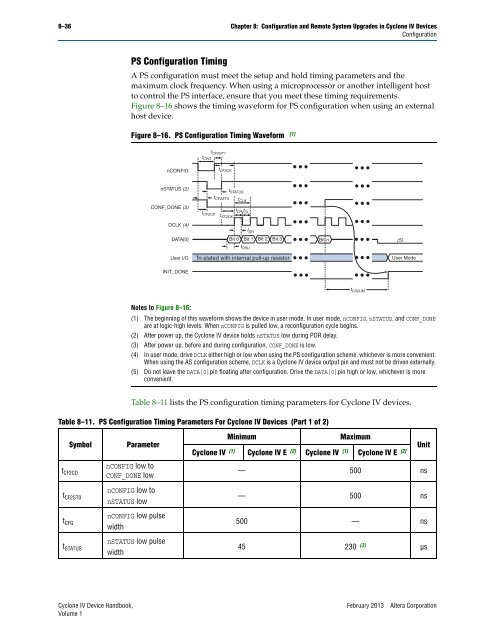Configuration and Remote System Upgrades in Cyclone IV ... - Altera
Configuration and Remote System Upgrades in Cyclone IV ... - Altera
Configuration and Remote System Upgrades in Cyclone IV ... - Altera
Create successful ePaper yourself
Turn your PDF publications into a flip-book with our unique Google optimized e-Paper software.
8–36 Chapter 8: <strong>Configuration</strong> <strong>and</strong> <strong>Remote</strong> <strong>System</strong> <strong>Upgrades</strong> <strong>in</strong> <strong>Cyclone</strong> <strong>IV</strong> Devices<br />
<strong>Configuration</strong><br />
PS <strong>Configuration</strong> Tim<strong>in</strong>g<br />
A PS configuration must meet the setup <strong>and</strong> hold tim<strong>in</strong>g parameters <strong>and</strong> the<br />
maximum clock frequency. When us<strong>in</strong>g a microprocessor or another <strong>in</strong>telligent host<br />
to control the PS <strong>in</strong>terface, ensure that you meet these tim<strong>in</strong>g requirements.<br />
Figure 8–16 shows the tim<strong>in</strong>g waveform for PS configuration when us<strong>in</strong>g an external<br />
host device.<br />
Figure 8–16. PS <strong>Configuration</strong> Tim<strong>in</strong>g Waveform (1)<br />
nCONFIG<br />
nSTATUS (2)<br />
CONF_DONE (3)<br />
DCLK (4)<br />
DATA[0]<br />
User I/O<br />
INIT_DONE<br />
Notes to Figure 8–16:<br />
t CFG<br />
t CF2CD<br />
t CF2ST1<br />
t CF2CK<br />
t CF2ST0<br />
t ST2CK<br />
t STATUS<br />
t CLK<br />
t CH t CL<br />
Bit 0<br />
tDH Bit 1 Bit 2 Bit 3 Bit n<br />
t DSU<br />
Tri-stated with <strong>in</strong>ternal pull-up resistor<br />
(1) The beg<strong>in</strong>n<strong>in</strong>g of this waveform shows the device <strong>in</strong> user mode. In user mode, nCONFIG, nSTATUS, <strong>and</strong> CONF_DONE<br />
are at logic-high levels. When nCONFIG is pulled low, a reconfiguration cycle beg<strong>in</strong>s.<br />
(2) After power up, the <strong>Cyclone</strong> <strong>IV</strong> device holds nSTATUS low dur<strong>in</strong>g POR delay.<br />
(3) After power up, before <strong>and</strong> dur<strong>in</strong>g configuration, CONF_DONE is low.<br />
(4) In user mode, drive DCLK either high or low when us<strong>in</strong>g the PS configuration scheme, whichever is more convenient.<br />
When us<strong>in</strong>g the AS configuration scheme, DCLK is a <strong>Cyclone</strong> <strong>IV</strong> device output p<strong>in</strong> <strong>and</strong> must not be driven externally.<br />
(5) Do not leave the DATA[0]p<strong>in</strong> float<strong>in</strong>g after configuration. Drive the DATA[0]p<strong>in</strong> high or low, whichever is more<br />
convenient.<br />
Table 8–11 lists the PS configuration tim<strong>in</strong>g parameters for <strong>Cyclone</strong> <strong>IV</strong> devices.<br />
Table 8–11. PS <strong>Configuration</strong> Tim<strong>in</strong>g Parameters For <strong>Cyclone</strong> <strong>IV</strong> Devices (Part 1 of 2)<br />
Symbol Parameter<br />
t CF2CD<br />
t CF2ST0<br />
t CFG<br />
t STATUS<br />
nCONFIG low to<br />
CONF_DONE low<br />
nCONFIG low to<br />
nSTATUS low<br />
nCONFIG low pulse<br />
width<br />
nSTATUS low pulse<br />
width<br />
<strong>Cyclone</strong> <strong>IV</strong> Device H<strong>and</strong>book, February 2013 <strong>Altera</strong> Corporation<br />
Volume 1<br />
t CD2UM<br />
M<strong>in</strong>imum Maximum<br />
(5)<br />
User Mode<br />
<strong>Cyclone</strong> <strong>IV</strong> (1) <strong>Cyclone</strong> <strong>IV</strong> E (2) <strong>Cyclone</strong> <strong>IV</strong> (1) <strong>Cyclone</strong> <strong>IV</strong> E (2)<br />
Unit<br />
— 500 ns<br />
— 500 ns<br />
500 — ns<br />
45 230 (3) µs
















